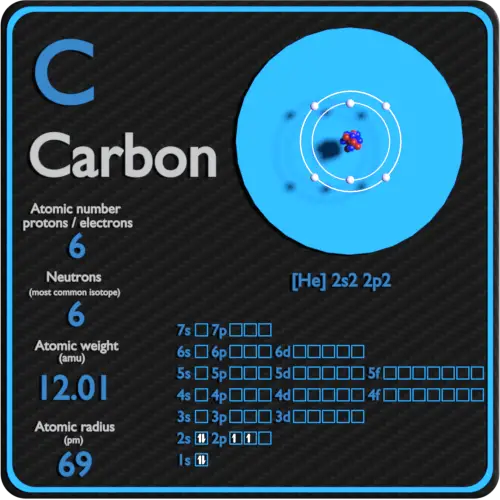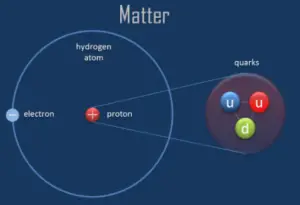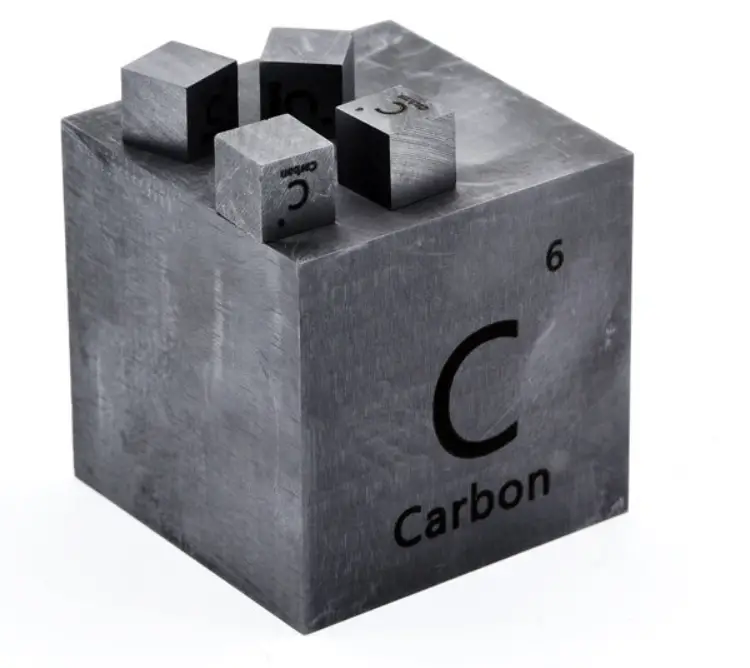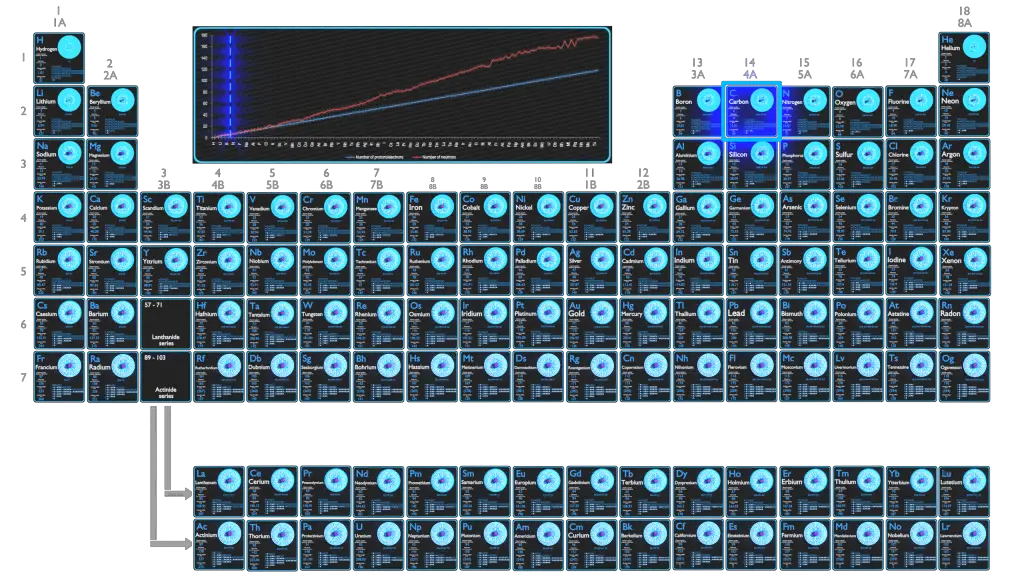Carbon is nonmetallic and tetravalent—making four electrons available to form covalent chemical bonds. Carbon is one of the few elements known since antiquity.
The major economic use of carbon other than food and wood is in the form of hydrocarbons, most notably the fossil fuel methane gas and crude oil (petroleum). Graphite and diamonds are two important allotropes of carbon that have wide applications. The uses of carbon and its compounds are extremely varied.
Graphite, diamond and other carbon forms are directly obtained from mines.
Protons and Neutrons in Carbon
 Carbon is a chemical element with atomic number 6 which means there are 6 protons in its nucleus. Total number of protons in the nucleus is called the atomic number of the atom and is given the symbol Z. The total electrical charge of the nucleus is therefore +Ze, where e (elementary charge) equals to 1,602 x 10-19 coulombs.
Carbon is a chemical element with atomic number 6 which means there are 6 protons in its nucleus. Total number of protons in the nucleus is called the atomic number of the atom and is given the symbol Z. The total electrical charge of the nucleus is therefore +Ze, where e (elementary charge) equals to 1,602 x 10-19 coulombs.
The total number of neutrons in the nucleus of an atom is called the neutron number of the atom and is given the symbol N. Neutron number plus atomic number equals atomic mass number: N+Z=A. The difference between the neutron number and the atomic number is known as the neutron excess: D = N – Z = A – 2Z.
For stable elements, there is usually a variety of stable isotopes. Isotopes are nuclides that have the same atomic number and are therefore the same element, but differ in the number of neutrons. Mass numbers of typical isotopes of Carbon are 12; 13.
Main Isotopes of Carbon
Carbon has 15 known isotopes, from 8C to 22C, of which 12C and 13C are stable. The longest-lived radioisotope is 14C, with a half-life of 5,730 years.
Carbon-12 is the more abundant of the two stable isotopes of carbon (carbon-13 being the other), amounting to 98.93% of the element carbon. Carbon-12 is of particular importance in its use as the standard from which atomic masses of all nuclides are measured, thus, its atomic mass is exactly 12 daltons by definition. Carbon-12 is composed of 6 protons, 6 neutrons, and 6 electrons.
Carbon-13 is a natural, stable isotope of carbon with a nucleus containing six protons and seven neutrons. As one of the environmental isotopes, it makes up about 1.1% of all natural carbon on Earth.
The only cosmogenic radionuclide to make a significant contribution to internal exposure of human is carbon-14. Radioactive carbon-14 has a half-life of 5730 years and undergoes β− decay, where the neutron is converted into a proton, an electron, and an electron antineutrino. Carbon-14 can also be produced in the atmosphere by other neutron reactions, including in particular 13C(n,γ)14C and 17O(n,α)14C. As a result, carbon-14 is continuously formed in the upper atmosphere by the interaction of cosmic rays with atmospheric nitrogen. On average just one out of every 1.3 x 1012 carbon atoms in the atmosphere is a radioactive carbon-14 atom. As a result, all living biological substances contain the same amount of C-14 per gram of carbon, that is 0.3 Bq of carbon-14 activity per gram of carbon.
Stable Isotopes
| Isotope | Abundance | Neutron Number |
| 12C | 98.9 | 6 |
| 13C | 1.1 | 7 |
Typical Unstable Isotopes
| Isotope | Half-life | Decay Mode | Product |
| 11C | 20 min | positive beta decay | 11B |
| 14C | 5730 y | beta decay | 14N |
Electrons and Electron Configuration
The number of electrons in an electrically-neutral atom is the same as the number of protons in the nucleus. Therefore, the number of electrons in neutral atom of Carbon is 6. Each electron is influenced by the electric fields produced by the positive nuclear charge and the other (Z – 1) negative electrons in the atom.
Since the number of electrons and their arrangement are responsible for the chemical behavior of atoms, the atomic number identifies the various chemical elements. The configuration of these electrons follows from the principles of quantum mechanics. The number of electrons in each element’s electron shells, particularly the outermost valence shell, is the primary factor in determining its chemical bonding behavior. In the periodic table, the elements are listed in order of increasing atomic number Z.
Electron configuration of Carbon is [He] 2s2 2p2.
Possible oxidation states are -4; -3 …; + 4.
Carbon is known to form almost ten million compounds, a large majority of all chemical compounds. It is typical tetravalent element —making four electrons available to form covalent chemical bonds. Carbon occurs in all known organic life and is the basis of organic chemistry. When united with hydrogen, it forms various hydrocarbons that are important to industry as refrigerants, lubricants, solvents, as chemical feedstock for the manufacture of plastics and petrochemicals, and as fossil fuels.
Most Common Chemical Compound of Carbon
Carbon dioxide molecules consist of a carbon atom covalently double bonded to two oxygen atoms. Carbon dioxide is a colorless gas with a density about 53% higher than that of dry air. It is relatively nontoxic and noncombustible, but it is heavier than air and may asphyxiate by the displacement of air. When CO2 is solved in water, the mild carbonic acid, is formed. Cooled CO2 in solid form is called dry ice. Carbon dioxide is a minor component of Earth’s atmosphere but important constituent of air. It is a necessary raw material for most plant life, which remove carbon dioxide from air using the process of photosynthesis. A typical concentration of CO2 in air is currently about 0.040% or 404 ppm. The concentration of atmospheric carbon dioxide rises and falls in a seasonal pattern over a range of about 6 ppmv. The concentration of CO2 in air has also been steadily increasing from year to year for over 70 years. The current rate of increase is about 2.5 ppm per year.
Summary
| Element | Carbon |
| Number of protons | 6 |
| Number of neutrons (typical isotopes) | 12; 13 |
| Number of electrons | 6 |
| Electron configuration | [He] 2s2 2p2 |
| Oxidation states | -4; -3 …; + 4 |
Source: www.luciteria.com












